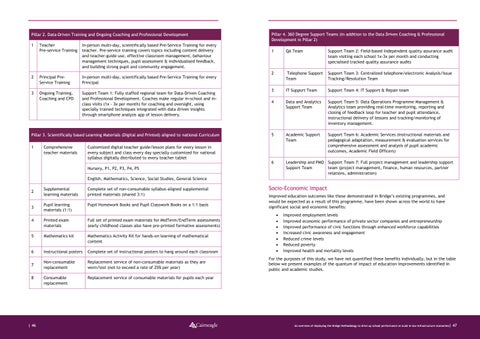Pillar 2. Data-Driven Training and Ongoing Coaching and Professional Development 1
Teacher Pre-service Training
In-person multi-day, scientifically based Pre-Service Training for every teacher. Pre-service training covers topics including content delivery and teacher-guide use, effective classroom management, behaviour management techniques, pupil assessment & individualised feedback, and building strong pupil and community engagement.
2
Principal PreService Training
In-person multi-day, scientifically based Pre-Service Training for every Principal
3
Ongoing Training, Coaching and CPD
Support Team 1: Fully staffed regional team for Data-Driven Coaching and Professional Development. Coaches make regular in-school and inclass visits (1x - 3x per month) for coaching and oversight, using specially trained techniques integrated with data driven insights through smartphone analysis app of lesson delivery.
Pillar 3. Scientifically based Learning Materials (Digital and Printed) aligned to national Curriculum 1
Comprehensive teacher materials
Customized digital teacher guide/lesson plans for every lesson in every subject and class every day specially customized for national syllabus digitally distributed to every teacher tablet
Pillar 4. 360 Degree Support Teams (in addition to the Data Driven Coaching & Professional Development in Pillar 2) 1
QA Team
Support Team 2: Field-based Independent quality assurance audit team visiting each school 1x-3x per month and conducting specialised tracked quality assurance audits
2
Telephone Support Team
Support Team 3: Centralized telephone/electronic Analysis/Issue Tracking/Resolution Team
3
IT Support Team
Support Team 4: IT Support & Repair team
4
Data and Analytics Support Team
Support Team 5: Data Operations Programme Management & Analytics team providing real-time monitoring, reporting and closing of feedback loop for teacher and pupil attendance, instructional delivery of lessons and tracking/monitoring of inventory management.
5
Academic Support Team
Support Team 6: Academic Services (instructional materials and pedagogical adaptation, measurement & evaluation services for comprehensive assessment and analysis of pupil academic outcomes, Academic Field Officers)
6
Leadership and PMO Support Team 7: Full project management and leadership support Support Team team (project management, finance, human resources, partner relations, administration)
Nursery, P1, P2, P3, P4, P5 English, Mathematics, Science, Social Studies, General Science 2
Supplemental learning materials
Complete set of non-consumable syllabus-aligned supplemental printed materials (shared 3:1)
3
Pupil learning materials (1:1)
Pupil Homework Books and Pupil Classwork Books on a 1:1 basis
4
Printed exam materials
Full set of printed exam materials for MidTerm/EndTerm assessments (early childhood classes also have pre-printed formative assessments)
5
Mathematics kit
Mathematics Activity Kit for hands-on learning of mathematical content
6
Instructional posters
Complete set of instructional posters to hang around each classroom
7
Non-consumable replacement
Replacement service of non-consumable materials as they are worn/lost (not to exceed a rate of 25% per year)
Consumable replacement
Replacement service of consumable materials for pupils each year
8
| 46
Socio-Economic Impact Improved education outcomes like those demonstrated in Bridge’s existing programmes, and would be expected as a result of this programme, have been shown across the world to have significant social and economic benefits: • • • • • • •
Improved employment levels Improved economic performance of private sector companies and entrepreneurship Improved performance of civic functions through enhanced workforce capabilities Increased civic awareness and engagement Reduced crime levels Reduced poverty Improved health and mortality levels
For the purposes of this study, we have not quantified these benefits individually, but in the table below we present examples of the quantum of impact of education improvements identified in public and academic studies.
An overview of deploying the Bridge Methodology to drive up school performance at scale in low infrastructure economies|
47





